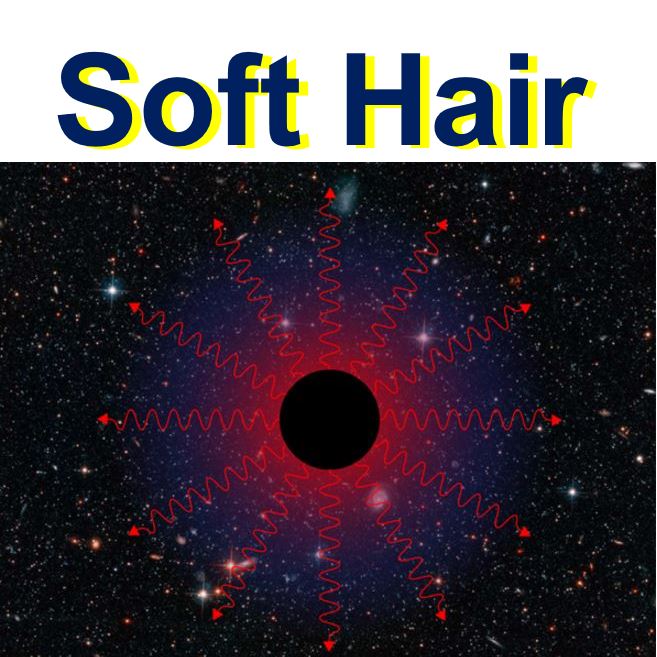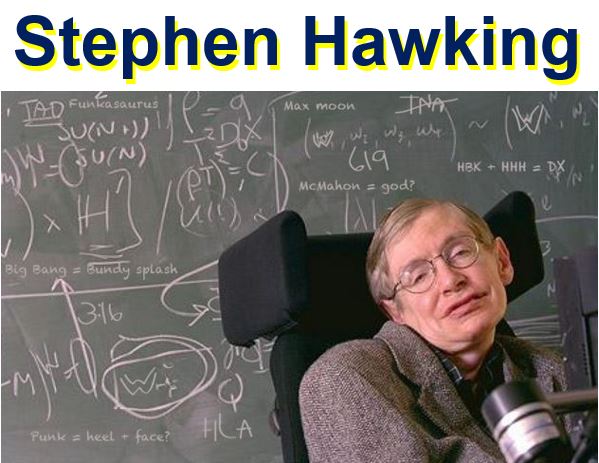Black holes may carry soft hair that release data when they evaporate, say Prof. Stephen Hawking and colleagues in a new published paper. The scientists suggest things might fall through a black hole into an alternate universe.
The soft hair, low-energy quantum excitations that release information when a black hole evaporates, mean that the holes are not quite as black as previously thought, Prof. Hawking, Malcolm J. Perry, and Andrew Strominger explained in the prestigious journal Physical Review Letters (citation below), a publication of the American Physical Society.
Andrew Strominger, Gwill E. York Professor of Physics at Harvard University’s Center for Fundamental Laws of Nature, explained that rather than destroying anything that comes within its gravitational pull, we might not have to be so scared of black holes.
 Hawking, Strominger and Perry suggest that black holes may have ‘soft hair’, low-energy quantum excitations that release information when the black hole evaporates. (Image: physics.aps.org)
Hawking, Strominger and Perry suggest that black holes may have ‘soft hair’, low-energy quantum excitations that release information when the black hole evaporates. (Image: physics.aps.org)
Four-decade-long controversy
In 1974, a year after meeting with Russian scientists in Moscow, Prof. Hawking proposed that black holes could destroy information – a conclusion that goes against the standard laws of quantum physics.
His idea triggered a controversy known as ‘black hole information problem’ – which has continued unresolved for a long time.
This new study shows that some of the assumptions that led to the information problem could be wrong. Their latest results do not solve the problem, but point to a research direction that could well lead to its solution.
Black holes are completely determined by only three observable parameters, so Albert Einstein’s general theory of relativity says:
– their charge,
– their mass, and
– their angular momentum.
 Prof. Hawking said: “If you feel you are trapped in a black hole, don’t give up.” (Image: hawking.org.uk)
Prof. Hawking said: “If you feel you are trapped in a black hole, don’t give up.” (Image: hawking.org.uk)
Virtually none of the information about what fell into the black hole can be observed from the outside. John Archibald Wheeler (1911-2008), an American theoretical physicist, described this idea by saying that ‘black holes have no hair’.
Black holes not really black
Prof. Hawking studied the behaviour of quantum matter in the vicinity of a black hole in 1975, and showed that they are not really ‘black’. They emit nearly thermal radiation, in the same way a hot object radiates heat.
If no matter at all falls in, the energy lost through such Hawking radiation will cause the black hole to gradually lose its mass and eventually disappear (evaporate)
This raises a question that nobody has been able to answer: “What happens to all the information stored within the black hole?”
Prof. Hawking argued that the information would be lost, given that Hawking radiation comes from the surface of the black hole, which is determined by only three parameters.
Just before the turn of the last century, other developments in physics – especially in string theory – convinced most scientists that all the data that falls back into a black hole has to come out when it evaporates.
Nobody is certain about how this could happen. However, we could start with a simpler question: “What is wrong in Hawking’s original argument that information must be lost?” Hawking, Strominger and Perry believe their paper provides the answer.
The authors point out problems with two underlying assumptions that initially led Prof. Hawking to his conclusion:
1. The vacuum quantum gravity – the quantum state with the tiniest possible energy – is unique.
2. Black holes have no hair.
 (Left) Prof. Malcolm Perry, (centre) Prof. Andrew Strominger, and Prof. Stephen Hawking. (Image: twitter.com/sciam)
(Left) Prof. Malcolm Perry, (centre) Prof. Andrew Strominger, and Prof. Stephen Hawking. (Image: twitter.com/sciam)
Black holes may carry ‘soft hair’
Instead, the authors explain that there is an infinite family of degenerate vacua in the quantum theory, and that black holes can carry what they call ‘soft hair’ – quantum hair associated with extremely-low-energy quanta. Quanta (plural of quantum) are discrete bundles in which radiation and other forms of energy occur.
In 1974, Prof. Strominger had an important insight while researching a different problem. He realized that there were an infinite numbers of conservation laws that govern the scattering of gravitons – hypothetical quantums (quanta) of gravitational energy, regarded as particles, i.e. the elementary excitations in a quantum theory of gravity.
Prof. Strominger and his team of students soon realised that a similar result held for electromagnetism. Prof. Strominger is currently collaborating with Prof. Hawking and Malcolm J. Perry, Professor of Theoretical Physics at Cambridge University’s Department of Applied Mathematics and Theoretical Physics (DAMTP), to apply this insight to black holes.
In their paper, the three scientists illustrate their ideas by considering electromagnetism in the presence of black holes.
The key to their argument regarding black hole hair is provided by new conservation laws which generalise the usual notion of conservation of electric charge. The total charge within an area can be obtained by integrating the radial component of the electric field around a sphere surrounding the area. If no charge leaves or enters the region, its value is independent of time.
Prof. Strominger’s generalisation is based on integrating – over a sphere with an infinite radius – the radial electric field weighted by an arbitrary function. This integral, it turns out, is still conserved. This provides a limitless number of new conserved quantities.
Stephen Hawking: Black holes are ‘not eternal prisons’ and we could escape them https://t.co/sYxMSOSCNL pic.twitter.com/XxP2eXbj7O
— Wired UK (@WiredUK) June 7, 2016
Comment in APS Physics
Gary T. Horowitz, a Distinguished Professor of Physics at the University of California, Santa Barbara, made the following comment regarding Prof. Strominger’s generalisation in an article in APS Physics:
“This observation connects to black hole hair in the following way. Using Gauss’ theorem, one can convert the surface integral describing the new conserved charge to a volume integral over all space. In the absence of black holes, the new conservation law simply means that this volume integral in the past is equal to the integral in the future.”
“However, if black holes are present, the integral in the future must include a contribution over the black hole horizon.”
If both electromagnetism and gravity are described classically, the contribution to the new charges originating from the black hole horizon must vanish.
However, in this paper the authors argue that the situation is quite different when electromagnetism is described in quantum mechanically. To appreciate the difference, first consider the vacuum state and then add one photon. What you get is a new quantum state with energy equal to the photon’s energy.
Watch @MarkAustinITV‘s full incredible interview with Professor Stephen Hawking here: https://t.co/dp6QSueH14https://t.co/1ULIpjg6qX
— Good Morning Britain (@GMB) May 31, 2016
As Prof. Strominger demonstrated, if you take the limit as the photon energy goes to zero – the photon becomes ‘soft’ with vanishing energy – the result is a new state, which can be called a new vacuum, given that it has essentially the same energy as the original vacuum state.
The first vacuum turns into the second one by acting with an operator that is just the quantum version of the new conserved charge.
The authors say their work now shows that acting with this same operator on the black hole’s event horizon adds photons with essentially zero energy. The ‘soft hair’ on a black hole is made up of these photons.
Given that there are an infinite number of soft hairs that a black hole can support, there are an infinite number of charges.
The authors also demonstrate that when a charged particle falls into the black hole, it excites some of its soft hair. The precise conservation of the new charges implies that when a black hole vanished, the information about the hair on the horizon must come out in the Hawking radiation.
Prof. Horowitz added:
“It is important to note that this paper does not solve the black hole information problem. First, the analysis must be repeated for gravity, rather than just electromagnetic fields.”
“The authors are currently pursuing this task, and their preliminary calculations indicate that the purely gravitational case will be similar. More importantly, the soft hair they introduce is probably not enough to capture all the information about what falls into a black hole.”
“By itself, it will likely not explain how all the information is recovered when a black hole evaporates, since it is unclear whether all the information can be transferred to the soft hair. However, it is certainly possible that, following the path indicated by this work, further investigation will uncover more hair of this type, and perhaps eventually lead to a resolution of the black hole information problem.”
Citation: “Soft Hair on Black Holes,” Stephen W. Hawking, Malcolm J. Perry, and Andrew Strominger. Physical Review Letters. Vol. 116, Iss. 23. Published 6 June 2016. DOI: 10.1103/PhysRevLett.116.231301.
Video – Do black holes have now hair?
In this video Prof. Hawking talks about black holes. “It is sometimes said that fact is stranger than fiction. To find out what I mean, watch this beautifully animated version of my first Reith lecture on black holes,” Prof. Hawking said.

